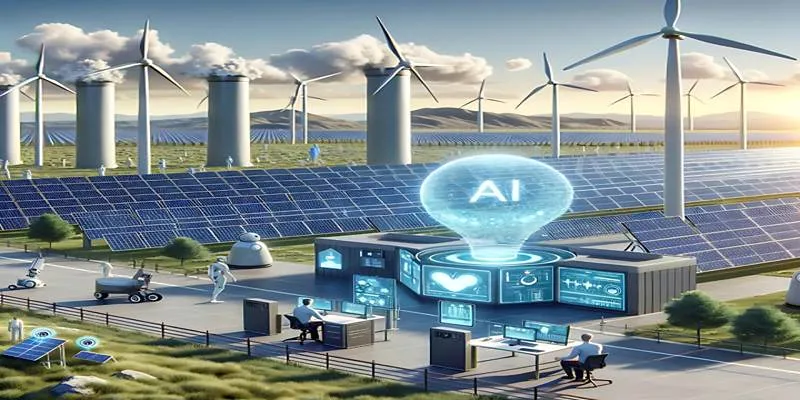AI-powered predictive analytics is revolutionizing energy demand forecasting by providing more accurate and efficient predictions. Traditional methods often struggle to account for the complexities of modern energy systems. With the rise of AI, energy providers can now leverage real-time data and advanced algorithms to make more precise forecasts.
This advancement allows for better grid management, cost reduction, and improved sustainability efforts. By continuously learning from data, AI systems can adapt to new trends and fluctuations in energy demand. This post will explore how AI is transforming energy demand forecasting and its key benefits for the industry.
What Is Predictive Analytics in Energy?
Predictive analytics in energy involves using statistics, machine learning algorithms, and data mining to anticipate future events based on historical data. This process, known as energy demand forecasting, analyzes vast amounts of past energy consumption data to accurately predict future energy needs.
AI enhances this process by employing machine learning models that learn from new data and adjust accordingly. These models consider various factors such as:
- Historical Consumption Data: Past consumption patterns are direct indicators of future demand.
- Weather Patterns: Temperature, humidity, and seasonal changes significantly impact energy usage, particularly for heating and cooling.
- Economic Factors: Economic growth or downturns influence energy demand.
- Demographic Factors: Urbanization, population growth, and changing consumer habits affect energy demand.
- Renewable Energy Production: Fluctuations in solar and wind energy production, influenced by weather conditions, require adjustments in demand forecasting.
Integrating these data sources with AI-powered predictive analytics results in more comprehensive and accurate predictions than traditional methods.
The Importance of Accurate Energy Demand Forecasting
Accurate energy demand forecasting is crucial for several areas of the energy industry, including:
- Balancing Supply and Demand: Ensuring supply meets demand is a significant challenge for energy companies. Excess supply can lead to waste, while insufficient supply can cause blackouts and other issues.
- Grid Management: By anticipating energy demand peaks, grid operators can adjust electricity flow to prevent overloading and maintain stability.
- Cost Reduction: Efficient demand forecasting enables energy producers to optimize production, reducing the costs associated with producing or purchasing additional energy on short notice.
How AI Is Enhancing Predictive Analytics for Energy Demand

AI is transforming predictive analytics in energy demand forecasting in several ways:
Real-Time Data Processing
AI’s ability to process real-time data is one of its most powerful features. By analyzing historical consumption data alongside real-time information, such as current weather conditions, AI systems can instantly adjust forecasts, allowing energy providers to respond quickly to demand fluctuations.
For example, weather patterns significantly influence energy consumption. Extreme weather events, like heatwaves or cold fronts, can lead to sudden spikes in electricity usage due to air conditioning or heating needs.
Machine Learning and Self-Improving Models
Machine learning (ML) algorithms are essential components of AI-driven forecasting. These algorithms learn from past data and continuously improve predictions over time. As more data becomes available, the model refines its understanding of energy demand patterns, resulting in better forecasts.
AI systems also detect hidden patterns in energy usage that may not be immediately obvious. For instance, they might uncover correlations between energy demand and less obvious factors, such as local events or holidays, which can influence consumption.
Big Data and IoT Integration
The integration of big data and the Internet of Things (IoT) has further empowered AI in energy demand forecasting. Smart meters, sensors, and connected devices generate extensive data on energy usage patterns, weather, and environmental conditions.
AI models can analyze this real-time data to fine-tune demand forecasts with unprecedented granularity. By monitoring energy consumption at the level of individual households or businesses, AI can predict shifts in demand more accurately, even on a minute-by-minute basis.
Types of AI Techniques Used in Energy Demand Forecasting
AI employs a variety of techniques to enhance predictive analytics in energy demand forecasting. Some of the most widely used AI techniques include:
Machine Learning (ML) Algorithms
Machine learning algorithms, such as decision trees, neural networks, and support vector machines, are commonly used for energy demand forecasting. These algorithms analyze historical consumption data and identify trends and patterns to predict future demand.
Deep Learning
Deep learning, a subset of machine learning, involves using multi-layered neural networks to analyze large and complex datasets. Deep learning models excel at handling non-linear relationships and can predict energy demand with high accuracy, even with messy or incomplete data.
Natural Language Processing (NLP)

Natural Language Processing (NLP) is a technique used by AI to analyze textual data, such as news articles or social media posts. By incorporating sentiment analysis or public discussions into demand forecasting models, AI can further refine its predictions. For instance, an AI system might use NLP to gauge public sentiment around energy consumption trends or changes that could affect energy demand.
Conclusion
AI-driven predictive analytics is reshaping the future of energy demand forecasting by providing more accurate, real-time predictions. As energy systems become more complex, AI’s ability to process vast amounts of data, adapt to changing patterns, and improve accuracy over time is crucial. By enhancing energy demand forecasts, AI helps optimize grid management, reduce costs, and support the integration of renewable energy sources, ultimately contributing to a more sustainable and efficient energy future.
 zfn9
zfn9






















